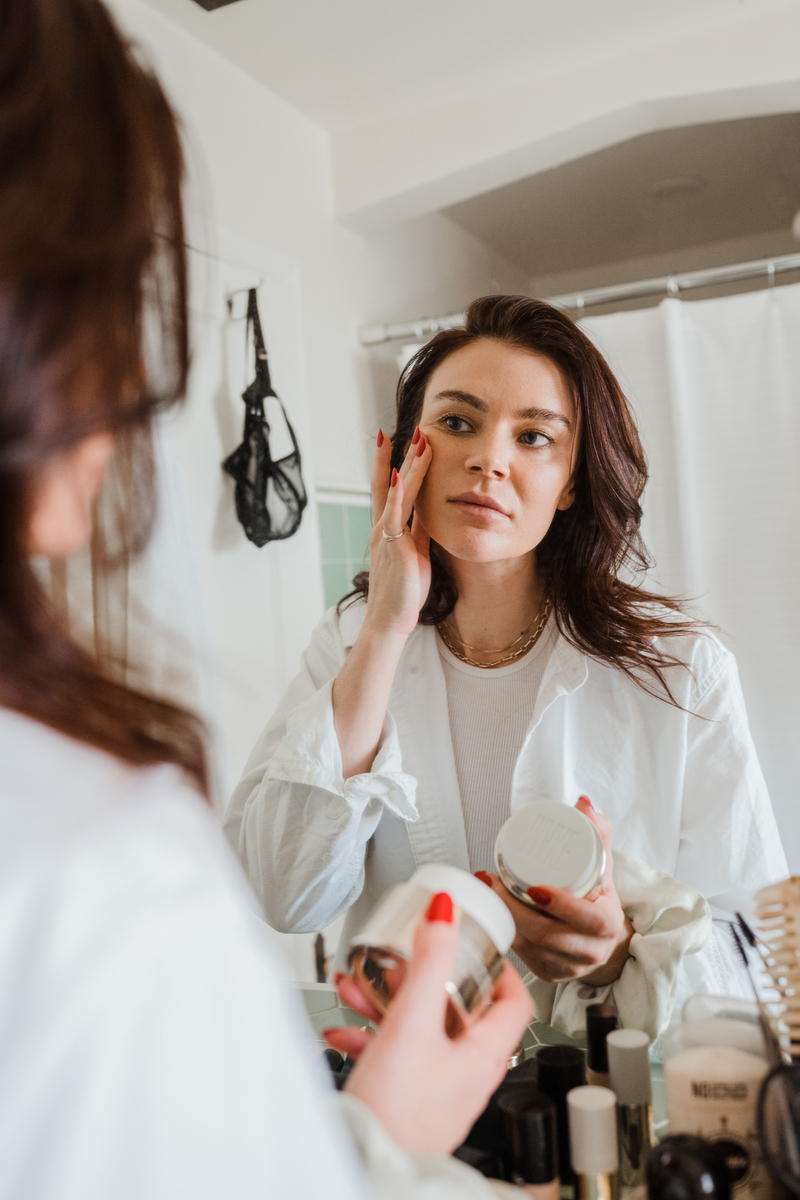Dreaming of Clear, Glowing Skin? It Just Might Be a Facial Massage Away
Plus why you should ditch the dry brush.

“You’re glowing”—it’s one of the best compliments in the world. It can also feel like one of the hardest to earn. Truly radiant, glowing skin, the kind that looks as if you’re fresh off a restorative vacation, can’t be achieved with highlighter or a shimmery cream. It has to come from within.
To gather the tips and products for how to get naturally glowing skin, we polled four beauty experts—Dr. Heather D. Rogers, dermatologist, dermatologic surgeon, and founder and CEO of Doctor Rogers; Dr. Nancy Samolitis, a dermatologist with specialized training in cosmetic dermatology; dermatological nurse and celebrity aesthetician Natalie Aguilar; and board-certified dermatologist, Dr. Elyse Love. Ahead, you’ll find quick, short-term fixes for instant radiance as well as our experts’ tips for how to play the long game when it comes to healthy, lit-from-within skin.
Read on to discover our guide to clear, naturally glowing skin, including at-home tips, noninvasive treatments, and the best skin care products in the game.
Featured image by Michelle Nash.
Try a Quickie Facial Massage
Want to get the blood flowing? Try a hands-on approach to wake up your face now and help keep skin firm in the long run.
“Facial massage is a great way to get swelling out of the face. There are many techniques, but Joomee Song is the ultimate guru to whom everyone in Hollywood turns,” Dr. Rogers shares. (Discover Song’s guide to an at-home facial massage here.)
Our experts also pointed to a few at-home tools that can increase circulation and nourish skin cells. “When used correctly, they also have contouring effects and aid in a decrease of puffiness by stimulating lymphatic drainage,” Aguilar adds.
Nail Your Exfoliation Routine
Exfoliating regularly is helpful for staving off dull skin, but it can be difficult to nail a routine that does more good than harm. Thankfully, Dr. Rogers has some pro tips on how to exfoliate safely without damaging your moisture barrier.
Don’t overdo it! As with everything in life, you can have too much of a good thing, so you need to start slowly and work out what products your skin can tolerate and how often you apply them. Consider your age. As you age, the frequency you can exfoliate will become less and less. When you’re 20, you might be able to use an exfoliator every day. By the time you’re 35, it might be three times a week. And by the time you’re 45, it might be once or twice a week. As our skin ages, it gets thinner, our blood vessels get closer to the surface, we absorb more of the chemicals we’re putting on our skin, and our skin is more likely to get irritated. But the older we are, the longer it takes your skin to replace itself, and the more critical it becomes to exfoliate your face and your entire body. You only need to do it a few times a week, but do it everywhere to maintain that smooth, soft skin.Don’t do manual exfoliation of any kind. Don’t do dry brushing, and don’t do scrubs because they can easily damage your skin. There’s nothing to prevent those brushes, scrubs, beads, salt, and nutshells from penetrating too deep, causing micro-cuts that lead to water loss, inflammation, collagen breakdown, and skin aging. Follow the data. If you look at the data, chemical exfoliators are the gold standard. They are safer and more effective than DIY scrubs and other manual exfoliators.Have a plan if your skin gets irritated. If your skin gets red, dry, or flakey, stop exfoliating and only use well-formulated products with the fewest yet most effective ingredients to soothe the skin. These include the Doctor Rogers Face Wash, the Face Cream, and a zinc-based sunscreen. As your skin gets back to normal (which usually takes 28 days), you can slowly start adding back your exfoliating steps. But if you reintroduce exfoliants too soon, they’re only going to irritate you again!A few more expert exfoliating insights…
Consider the time of day. Apply your Vitamin C serum in the morning to prevent damage from free radicals that can occur throughout the day. Apply a chemical exfoliator at night and always follow that application with a thick, well-formulated moisturizer.Don’t forget the SPF. Exfoliation removes the protective layer on the surface of your skin and brings new cells to the surface, which makes your skin more vulnerable to UV rays.Slip on a Hydrating Sheet Mask
Not all our experts were keen on recommending sheet masks for a long-term glow, though they agree they can be helpful when your skin needs soothing. However, in Biologique Recherche we—and Aguilar—trust.
Consider Calling in the Pros for a Quick Glow
Non-invasive aesthetic treatments are at an all-time high. Beyond the PlasmaSculpts and thread lifts, there are a variety of new lasers, radio-frequency tools, and peels that specifically target bright, glowing skin.
Ultrasound and Radiofrequency Treatments. “Exilis, Thermage, and Ultherapy help build collagen over time,” Dr. Rogers explains. “Directly after, your skin looks great from the heat and increased blood flow. Every year, I try to do Exilis around my birthday, so I look refreshed for my birth week.
Enzyme Facial Therapy. “This provides controlled exfoliation by dissolving dead skin cells while nourishing the layer of skin it leaves behind,” Aguilar shares. “Skin is left brighter, tighter, and hydrated. Many ingredients are available to customize for every unique client’s needs.”
Laser Genesis. “This is one of my favorite no-downtime laser treatments to instantly increase the skin’s radiance,” Dr. Love says.
Oxygen Therapy. “This treatment nourishes skin cells with 100% oxygen, essentially giving our skin cells more life,” Aguilar adds. “Oxygen therapy can help improve blood circulation to the face, which can help the skin look brighter.”
Which Skincare Ingredients Brighten Skin?
A lot of products claim to “brighten” skin. Several even have the name “glow” right in the title. But there’s a science to skincare that gets it just right. Our experts share six ingredients to look for that reveal clear, glowing skin.
“Brightening skincare products can be broken into two groups: one focuses on improving texture and pigment by promoting cell turnover,” Dr. Rogers explains. “These are products with ingredients like AHA, BHA, retinol, and bakuchiol. The second group prevents the changes from happening in the first place through skin protection, typically including antioxidants like vitamin C, E, and sunscreen.”
AHAs (glycolic acid and lactic acid) and BHAS (salicylic acid). “I love this group of ingredients because they effectively remove dead, dry, or dying skin cells without injuring the healthy ones,” Dr. Rogers adds. “Rome was not built in a day; it takes time to get outstanding results; you have to go slow and keep at it.”
Vitamin C. “Especially in the form of ascorbic acid,” Aguilar shares. “Vitamin C will never be overrated and it is a wonderful ingredient beneficial for all skin types. It is available in a gentle 5% for reactive skin types and 20% for more resilient skin. Its job is to brighten skin tone, lighten discoloration, stimulate collagen, and destroy free radicals that damage the skin.”
A Power Trio: Tranexamic Acid, Azelaic Acid, and Niacinamide. “They work well in harmony because they have different mechanisms by which they reduce excess skin pigmentation—as seen in melasma, sun damage, and post-inflammatory hyperpigmentation,” Dr. Samolitis says. “They are also very gentle, well-tolerated, and safe during pregnancy.”

 UsenB
UsenB 
































